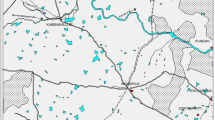Abstract
Occurrence of fluoride in natural water resources and the associated health hazards have been reported from many parts of India during the last decade. With the objective of organizing a systematic scientific programme to understand the geochemical behaviour of fluoride in natural water resources in relation to the local hydrogeological, climatic conditions and agricultural use, a typical semi-arid terrain in the northwestern part of India was chosen for detailed study. The present work is an attempt to study the fluoride contamination in groundwater in parts of Jaipur district, Rajasthan state, and to assess the origin and genesis of fluoride in groundwater. The area, falling under the semi-arid tract of central Rajasthan, is geologically occupied by alluvial formations and Precambrian rocks (gneisses and schists) where groundwater occurs under unconfined to semi-confined conditions. A total of 66 groundwater samples was collected during the pre-monsoon period and analysed, which gave a concentration of fluoride in water in the range of 0.35 to 9.3 mg/l with 62 % of the samples in excess of permissible limit of 1.5 mg/l. As compared to alluvial formations, fluoride enrichment in groundwater is higher in hard rock areas. The samples collected from the granite gneissic terrain show higher values when compared to those in the schist. The groundwater of the shallow aquifers (soil–clay complex weathered zone) has a higher concentration of fluoride than the deep (fractured hard rock) aquifer does. The possible sources of fluoride are chemical weathering and leaching of fluorine-bearing minerals present in hard rocks and alluvial formations under the alkaline environment in arid to semi-arid conditions. High pH as well as alkalinity and low levels of Ca, Mg and total hardness suggest favourable chemical conditions for the fluoride dissolution process. A higher rate of evapotranspiration, intensive and long-term irrigation and heavy use of fertilizers are the supplementary factors that further increase the fluoride content in the groundwater. A groundwater management programme is suggested.








Similar content being viewed by others
References
Aiuppa A (2009) Degassing of halogens from basaltic volcanism: insights from volcanic gas observations. Chem Geol 263:99–109
Aiuppa A, Bonfatti P, Brusca L, D’alessandro W, Federico C, Parello F (2001) Evaluation of the environmental impact of volcanic emissions from the chemistry of rainwater: Mount Etna (Sicily). Appl Geochem 16:985–1000
Apambire WB, Boyle DR, Michel FA (1997) Geochemistry, genesis and health implications of fluoriferous groundwaters in the upper regions of Ghana. Environ Geol 33:13–24
American Public Health Association (APHA) (1995) Standard methods for the examination of water and wastewater, 19th edn. APHA, Washington DC
Berner EK, Berner Robert (1996) Global environment—water, rain and geochemical cycles. Prentice Hall, New Jersey
BIS (2003) Drinking Water Standards (I.S 10500-91, Revised 2003)
Brindha K, Rajesh R, Murugan R, Elango L (2011) Fluoride contamination in groundwater in parts of Nalgonda District, Andhra Pradesh, India. Environ Monit Assess 172:481–492
Bulusu KR, Nawlakhe WG (1990) Defluoridation of water with activated alumina, batch operations. Ind J Environ Health 32:197–218
CGWB (2006) Groundwater year book, Rajasthan. Central Ground Water Board, Ministry of Water Resources, Government of India, p 167
CGWB (2007) Ground water scenario of Jaipur district, Rajasthan. District groundwater brochure, Central Ground Water Board, Ministry of Water Resources, Government of India, pp 1–25
Chaudhary V, Kumar M, Sharma M, Yadav BS (2010) Fluoride, boron and nitrate toxicity in ground water of northwest Rajasthan, India. Environ Monit Assess 161:343–348
Choubisa SL (2001) Endemic fluorosis in southern Rajasthan. Fluoride 34:61–70
Cuoco E, Verrengia G, De Francesco S, Tedesco D (2010) Hydrogeochemistry of Roccamonfina volcano (Southern Italy). Environ Earth Sci 61:525–538
Deshkar SM, Deshmukh AN, Vali SA (1999) Safe limit of fluoride content in drinking water in different climatic zones of India. Ind J Environ Health 2(1):17–20
Fantong WY, Satake H, Ayonghe SN, Suh EC, Adelana SMA, Fantong EBS, Banseka HS, Gwanfogbe CD, Woincham LN, Uehara Y, Zhang J (2010) Geochemical provenance and spatial distribution of fluoride in groundwater of Mayo Tsanaga River Basin, Far North Region, Cameroon: implications for incidence of fluorosis and optimal consumption dose. Environ Geochem Health 32:147–163
Gaciri SJ, Davis TC (1993) The occurrence and geochemistry of fluoride in some natural waters of Kenya. J Hydrol 143:395–412
Handa BK (1975) Geochemistry and genesis of fluoride containing groundwater in India. Groundwater 13:275–281
Harrison Paul TC (2005) Fluoride in water: A UK perspective. J Fluor Chem 126:1448–1456
Hem JD (1991) Study and interpretation of the chemical characteristics of natural water. Book 2254, 3rd edn. Scientific Publishers, Jodhpur, India
Jacks G, Rajagopalan K, Alveteg T, Jonsson M (1993) Genesis of high-F groundwaters, Southern India. Appl Geochem (Suppl 2): 241–244
Jacks G, Bhattacharya P, Chaudhary V, Singh KP (2005) Controls on the genesis of some high-fluoride groundwaters in India. App Geochem 20:221–228
Kim K, Jeong GY (2005) Factors influencing natural occurrence of fluoride-rich groundwaters: a case study in the southeastern part of the Korean Peninsula. Chemosphere 58:1399–1408
Kumar S, Saxena A (2011) Chemical weathering of the Indo-Gangetic Alluvium with special reference to release of fluoride in the groundwater, Unnao district, Uttar Pradesh. J Geol Soc India 77:459–477
Kundu N, Panigrahi MK, Tripathy S, Munshi S, Powell MA, Hart BR (2001) Geochemical appraisal of fluoride contamination of groundwater in the Nayagarh district of Orissa. India Environ Geol 41:451–460
Madhavan N, Subramanian V (2002) Fluoride in fractionated soil samples of Ajmer district, Rajasthan. J Environ Monit 4:821–822
Maithani PB, Gurjar R, Banerjee R, Balaji BK, Ramachandran S, Singh R (1998) Anomalous fluoride in groundwater from western part of Sirohi district, Rajasthan and its crippling effects on human health. Curr Sci 74:773–777
Muralidharan D, Nair AP, Sathyanarayana U (2002) Fluoride in shallow aquifers in Rajgarh tehsil of Churu district, Rajasthan—an arid environment. Curr Sci 83:699–702
Qinghai G, Yanxin W, Teng M, Rui M (2007) Geochemical processes controlling the elevated fluoride concentrations in groundwaters of the Taiyuan Basin, Northern China. J Geochem Explor 93:1–12
Ramamohana Rao NV, Suryaprakasa Rao K, Schuiling RD (1993) Fluorine distribution in waters of Nalgonda district, Andhra Pradesh, India. Environ Geol 21:84–89
Ramesham V, Rajagopalan KJ (1985) Fluoride ingestion into the natural water of hard rock areas, Peninsular India. J Geol Soc India 26:125–132
Ravindra K, Garg VK (2007) Hydro-chemical survey of groundwater of Hisar city and assessment of defluoridation methods used in India. Environ Monit Assess 132(1–3):33–43
Saxena VK, Ahmed S (2001) Dissolution of fluoride in groundwater: a water-rock interaction study. Environ Geol 40:1084–1087
Saxena VK, Ahmed S (2003) Inferring the chemical parameters for the dissolution of fluoride in groundwater. Environ Geol 43:731–736
Shukla S, Singh P, Rajwanshi P, Singh V, Gupta MK, Srivastava S, Dass S (1993) Fluoride content of commonly used chemical fertilizers. Proceedings of Indo-German conference on impact of modern agriculture on environment, Hisar Agriculture University, Hisar, India 111:59–62
Singh CK, Rina K, Singh RP, Shashtri S, Kamal V, Mukherjee S (2011) Geochemical modeling of high fluoride concentration in groundwater of Pokhran area of Rajasthan, India. Bull Environ Contam Toxicol 86:152–158
Sinha RK (1997) Fluorosis—a case study from the Sambhar Salt Lake region in Jaipur, Rajasthan, India. Environ 17:259–262
Strunz H (1970) Mineralogische Tabellen, 5. Aufl. Geest und Portig, Leipzig, Germany
Subba Rao N (2003) Groundwater quality: focus on fluoride concentration in rural parts of Guntur district, Andhra Pradesh, India. Hydrol Sci 48(5):835–847
Subba Rao N, John Devadas D (2003) Fluoride incidence in groundwaters in a part of Peninsular India. Environ Geol 45:243–253
Subba Rao N, Krishna Rao G, John Devadas D (1998) Variation of fluoride in groundwaters of crystalline terrain. J Environ Hydrol 6(3):1–5
Sujatha D (2003) Fluoride levels in the groundwater of the south-eastern part of Ranga Reddy district, Andhra Pradesh, India. Environ Geol 44:587–591
Susheela AK (1999) Fluorosis management programme in India. Curr Sci 77(10):1250–1256
Suthar S, Garg VK, Jangir S, Kaur S, Goswami N, Singh S (2007) Fluoride contamination in drinking water in rural habitations of northern Rajasthan, India. Environ Monit Assess 145:1–6
Tirumalesh K, Shivanna K, Jalihal AA (2007) Isotope hydrochemical approach to understand fluoride release into groundwaters of Ilkalarea, Bagalkot District, Karnataka, India. Hydrogeol J 15:589–598
UNICEF (1999) State of the art report on the extent of fluoride in drinking water and the resulting endemicity in India. Report by Fluorosis and Rural Development Foundation for UNICEF, New Delhi
Vikas C (2008) Geochemistry of groundwater—an overview of sporadic nitrate contamination in parts of Jaipur district, Rajasthan. India J Appl Geochem 10(2):166–172
Vikas C (2009) Occurrence and distribution of fluoride in groundwaters of central Rajasthan and associated health hazards. J Environ Sci Eng 51(3):169–174
Vikas C, Kushwaha RK, Pandit MK (2009) Hydrochemical status of groundwater in District Ajmer (NW India) with reference to fluoride distribution. J Geol Soc India 73:773–784
World Health Organisation (WHO) (2004) Guidelines for drinking water quality recommendations, 3rd edn. World Health Organisation, Geneva
Zhang B, Hong M, Zhang B, Zhang X, Zhao Y (2007) Fluorine distribution in aquatic environment and its health effect in the Western Region of the Songnen Plain, Northeast China. Environ Monit Assess 133:379–386
Acknowledgments
CV and RK are thankful to the Regional Director, Central Ground Water Board (CGWB), WR, Jaipur, Rajasthan for giving permission to carry out the work and publish this paper. The opinions offered by the authors do not necessarily reflect those of CGWB. Thanks are also due to Smt. Geeta for preparing the maps.
Author information
Authors and Affiliations
Corresponding author
Rights and permissions
About this article
Cite this article
Vikas, C., Kushwaha, R., Ahmad, W. et al. Genesis and geochemistry of high fluoride bearing groundwater from a semi-arid terrain of NW India. Environ Earth Sci 68, 289–305 (2013). https://doi.org/10.1007/s12665-012-1739-3
Received:
Accepted:
Published:
Issue Date:
DOI: https://doi.org/10.1007/s12665-012-1739-3




